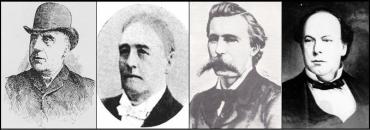Comprising operatic airs, popular songs of the day, ballets, and sumptuous costumes, the pantomime is also said to have been an outlet for Garnet Walch to exhibit 'his wonted faculty for word twisting', an aspect of the production that the Argus reports had been 'carried to an excess.' The paper's critic also draws attention to the author's ingenuity in inserting local allusions, topical hits, and satirical references, many of which targeted high-profile Melbourne personalities and current issues, including, for example, the Melbourne Cup, free trade, protection, and the denouncing of blackbirding (27 December 1876, p.6).
The story begins in a fishing village on the coast of Nowhere. Here, Bruno ('a fast youth, who cuts his eye teeth and his family at an early age') and Blondo ('his brother, a much better boy') live with their parents Gaffer and Gammo. When Mary, the Maid of the Inn, gives Blondo a lucky sixpence and Bruno a bag of rye, the latter brother is not happy with his gift and endeavours to sell the rye. When Bruno decides to take out his anger on his pet blackbird by torturing it (the excuse being that the bird wouldn't sing for him), Blondo steps in and offers to exchange his talisman for the bird and the rye. Blondo sets the bird free but it is immediately pursued by an eagle. After managing to escape, the bird is transformed into Pluma, a beautiful genie who becomes Blondo's protector. The eagle in turn becomes Aura, the sinister genie who attaches herself to Bruno. Because of his kindness and sacrifice, Pluma informs Blondo that she will help him achieve fame, fortune, and the hand of the beautiful Princess Caressa, whom she shows him in a vision.
With his future lying in the kingdom of Hey Diddle-Diddle, she sends Bruno on his quest, but not before turning the bag of rye into travelling companions: a cat that plays a fiddle, a cow that can jump over the moon, a little dog that laughs to see such sport, and a dish and a spoon. Unbeknownst to Blondo and Pluma, Aura has shown Bruno the same vision. Determined to beat her adversary, she urges Bruno to stall his brother and win the princess himself. The following scene (titled 'Around the World in Three-and-a-half Minutes') depicts the two brothers, along with their parents and Mary, setting forth by train to the palace of King Hey Diddle-Diddle. Along the journey, they meet a mysterious stranger named Vagabond (actually a reporter in disguise), who is charmed by Blondo's appreciation of certain clever newspaper articles and subsequently declares himself to be on the lad's side.
At the court of King Hey Diddle Diddle, which is preparing for a royal fete, the audience learns that the king has been deprived of his melodious voice after swallowing his penny whistle. Worse than this, however, is the conspiracy that is beginning to unfold within his court. Count Opodeldoc, the royal physician, has already begun to hatch a plan with the court pastry cook, Von Krisiman, which will see them to serve poison lollies to the court during the fete. With the king's household and loyal supporters dispatched, the count will then take control of the kingdom and install himself as the new monarch. Their diabolical scheme is overheard by Vagabond, now in a new disguise, and he declares that he will find a way to stop them, no matter what it takes. In the scene that follows, the two brothers are presented to the court. Bruno, who has been transformed into an immensely rich prince, courtesy of Aura, is presented to the king and his queen first. They are so impressed by his wealth that they accept him as a suitor for the hand of their daughter. Blondo is then granted an audience with the royal couple. He manages to usurp his brother not by having access to immense riches but rather by dazzling the princess with his clever traveling companions. The king is also impressed by the young man's display and tells him that can choose any young lady from the court as his wife should his cow manage to the magical feat claimed for it. With his goal in sight, Blondo commands Betsy to make her giant leap but just as she is ready to do so, Bruno rubs his magic sixpence and the cow fails even to leave the ground.
Although greatly humiliated, Blondo regains his composure upon the arrival of a giant blackbird pie. Reminding himself that he is Pluma's protégé and thus the champion of those birds, he denounces the crime of blackbirding, cuts open the pie, and restores the birds to life before releasing them. Instead of flying off, however, they immediately turn on the pie's maker and devour him, thereby taking away Count Opodeldoc's only ally. Forced to act quickly, the count passes out the lollies himself and within seconds the court is in a state of horror and confusion as people fall to the ground stricken by the poison. When the count informs everyone that they have less than five minutes to live, Vagabond (now disguised as an old astrologer) emerges with an antidote and distributes it to all. The count manages to escape, but not before hearing the astrologer's prophecy that all will be well in the kingdom when a cow jumps over the moon. He sets forth to knobble Daisy, but is again foiled by Vagabond. Blondo also manages to foil his brother's plans by getting back his lucky sixpence after Bruno (who has suffered an unmerciful snubbing by the princess) loses it in an unguarded moment. Seizing his opportunity, Blondo takes the princess to a moonlight rendezvous in the Haunted Glenn, and it is here (with the aid of the talisman) that Daisy jumps over the moon, and so brings about much happiness, reconciliations, and, of course, the marriage between Blondo and Princess Caressa (Age 25 December 1876, p.3).


